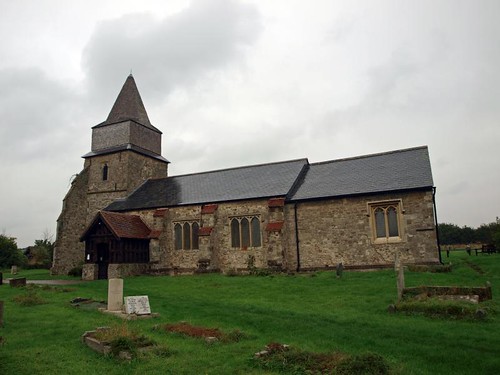ST MARGARET. Small church, quite on its own. The charm of the church is the huge diagonal buttress propping the small W tower at the SW corner only, and the asymmetrically placed W windows of the tower. The tower top and broach spire weather-boarded. Inside, this wooden upper part rests on unbraced posts with trellis strutting. - CHANCEL SCREEN. 1926 by Sir Charles Nicholson. - FONT COVER. Polygonal pyramid, C17. - BRASS. 6 feet tall figure of c. 1350, said to represent Sir John Gifford. d. 1348. The head not preserved. Shield with lovely fleur-de-lis and trail pattern. Legs not crossed.
BOWERS GIFFORD. It is still growing about the road to Southend. From this road a long and shady lane runs down the hill to the marshy levels recovered from the Thames, bringing us to a Tudor church with a quaint stone tower, a wooden belfry, and a six-sided spire.
A few things remain from an earlier church: two bells of the 14th century, a piscina of the 15th, a font with a coloured cover of the 16th, and a magnificent lifesize brass said to represent Sir John Gifford, who died about 1340. Though the head and a leg are missing, the costume and the armour are preserved and are unique, showing us what a knight wore when the first ball was fired from a cannon. It is the third oldest military brass in Essex, and valuable to artists as an important link in our knowledge of dress.
Behind the choir-stalls is a memorial to a lady buried in the shade of the elms. She was Flora Mary Campbell, who died in 19l5, and this is how her friends described her:
Ever the seeker after truth, a lover of science and nature, wild beasts and trees of the forests, the sovereign birds of the air, the flowers of the field, the fishes of the sea, the constellations of the heavens, she has at last attained unto the open vision.
Twenty years ago the church was restored and beautified by Sir Duncan Campbell, who owned Earls Fee, the old manor of the De Veres. On a wall of the nave is a tablet placed by him to Sir John de Vere, 15th Earl of Oxford, who bore the crown at the coronation of Anne Boleyn and now lies at Castle Hedingham. Another tablet recalls Aubrey, the last of the famous De Vere family which came over with the Conqueror. He is described as the noblest subject in England, and indeed, as Englishmen loved to say, the noblest subject in Europe. He died in 1703 and the title was not revived until Mr Asquith chose it.
A few things remain from an earlier church: two bells of the 14th century, a piscina of the 15th, a font with a coloured cover of the 16th, and a magnificent lifesize brass said to represent Sir John Gifford, who died about 1340. Though the head and a leg are missing, the costume and the armour are preserved and are unique, showing us what a knight wore when the first ball was fired from a cannon. It is the third oldest military brass in Essex, and valuable to artists as an important link in our knowledge of dress.
Behind the choir-stalls is a memorial to a lady buried in the shade of the elms. She was Flora Mary Campbell, who died in 19l5, and this is how her friends described her:
Ever the seeker after truth, a lover of science and nature, wild beasts and trees of the forests, the sovereign birds of the air, the flowers of the field, the fishes of the sea, the constellations of the heavens, she has at last attained unto the open vision.
Twenty years ago the church was restored and beautified by Sir Duncan Campbell, who owned Earls Fee, the old manor of the De Veres. On a wall of the nave is a tablet placed by him to Sir John de Vere, 15th Earl of Oxford, who bore the crown at the coronation of Anne Boleyn and now lies at Castle Hedingham. Another tablet recalls Aubrey, the last of the famous De Vere family which came over with the Conqueror. He is described as the noblest subject in England, and indeed, as Englishmen loved to say, the noblest subject in Europe. He died in 1703 and the title was not revived until Mr Asquith chose it.

No comments:
Post a Comment